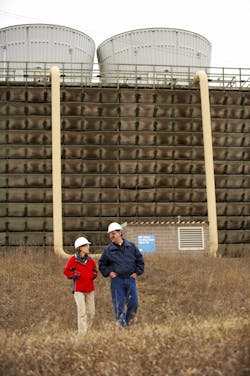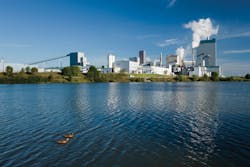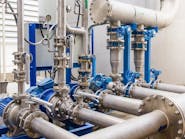Water-related risks drive strategic water management practices
By Jeff Gunderson
Over the last decade, the pulp and paper sector has made meaningful strides in embracing water stewardship, prompted by rising global water scarcity concerns and greater recognition among companies of the risks they face related to water. As one of the most water-intensive industries, pulp and paper operations are inextricably linked to water in many ways, and in an era of greater water awareness, the way in which big water users approach their water management and address their water-related risks carries more significance than ever before.
The World Wide Fund for Nature (WWF), a leading advocate in the water stewardship space, identifies water risks as physical, regulatory and reputational, all of which can ultimately pose a financial risk to businesses. WWF recommends that companies set out to understand and comprehensively address their water-related risks as part of a strategic business planning process, emphasizing that “the cost of inaction is great, but so too is the opportunity presented by taking a water stewardship approach.”
To help companies better assess and respond to water issues — and in the process, become better water stewards — WWF publishes the Water Risk Filter, an online tool for corporate water risk assessment. Drawing on site-specific water risk data, WWF’s filter provides a starting point for analyzing both basin and operational risks and guiding users to the appropriate response actions to mitigate them. Understanding the full spectrum of risks, WWF argues, is the key to the development of a comprehensive water stewardship strategy.
Genesis Water Technologies designed an aeration basin as part of a paper mill’s aerobic water treatment process. Photo Credit: Genesis Water Technologies.
Characterizing Water Risk Factors
Pulp and paper processes require abundant volumes of fresh water, with water used extensively throughout all major process stages. Impacts to supplies can pose severe operational disruptions, from production stoppages all the way to plant closures. The physical risks of water to a pulp and paper mill can include water shortages and flooding, but equally as concerning as quantity-related risks are those related to quality, said Nick Nicholas, application engineer and technical director with Genesis Water Technologies, a sustainable water treatment solutions provider.
“Mills need to manage for potential raw water quality changes that can affect their processes,” he said. “Source water quality impacts can originate from another upstream industrial discharger or from a natural event such as a microalgae outbreak in a lake source.”
Facilities also need to be prepared for the possibility of regulatory risks such as curbs on water withdrawals that can come from mandates to protect aquifers from over pumping or orders to preserve supplies during water crises, which are increasingly common in areas susceptible to water stress.
The reputational risk associated with a pulp and paper company’s water usage is another category that is viewed as a significant driver for the adoption of water stewardship programs and conservation efforts. According to WWF, industries like pulp and paper rely on a social license to operate and if a business fails to meet social expectations it can experience scrutiny from the local social environment as well as from customers, consumers, and civil society groups. A lack of a clear commitment to corporate responsibility and water stewardship could also hinder a company’s ability to attract employees.
“We see these risks driving more pulp and paper companies to put in place water sustainability programs and to consider how they can recycle water or optimize their operations to use water more efficiently,” Nicholas said.
Influent water for a paper mill to be treated by a water purification process from Genesis Water Technologies. Photo Credit: Genesis Water Technologies.
Making a Stronger Economic Case
for Water-Saving Projects
Water conservation measures are the backbone of an effective water stewardship program, but the relatively low cost to access water has historically made water-saving projects difficult to rationalize from a cost return perspective. However, this outlook has shifted in recent years as companies have come to understand the implications of water shortages, declining quality, or a poor brand image. Increasingly, the cost risks of water — and the importance of addressing them — are being factored into business strategies.
“When water risks are quantified into a cost perspective, water projects do offer a payback,” Nicholas said. “Pulp and paper companies and other heavy water users are also starting to place a monetary value on the social benefits of water stewardship — they can trace how different strategies affect their market reputation and sales.”
Another water risk tool that analyzes water-related risks in financial terms is the Water Risk Monetizer, a free online platform developed by Ecolab in partnership with Trucost and Microsoft that enables companies to understand the gap between what they pay for water and the potential costs of water risks to their business. To help companies monetize water-related business risks and assess impacts on operations, the Water Risk Monetizer considers tangible factors such as scarcity and quality as well as less tangible human, health and environmental impacts of water use in specific areas to determine risk levels and display risks in comparison to current water costs.
Nalco Water field representatives outside of a paper mill cooling tower. Photo: Ecolab/Nalco Water.
“Our goal with this platform was to pioneer the visibility into the true cost of water,” said Michael Ancona, vice president of paper services marketing for Nalco Water, an Ecolab company. “The traditional view of water is that it’s a cheap resource, but when you take into consideration everything that a mill needs to put into and take out of water in order to carry it from the inlet of the process to the outlet, it becomes clear that water is anything but cheap,” he said.
Domtar’s pulp mill in Dryden, Ontario.
Following the Money
In a similar approach to Ecolab’s tool for determining a more accurate value of water, pulp and paper manufacturer Domtar, which operates a network of 13 pulp and paper mills and 10 paper converting facilities in North America, set out to better understand the full costs of water utilization within its manufacturing facilities. Because the company’s mills operate in areas with ample water supplies, rely mainly on surface water that is essentially “free” and return more than 90 percent of water used back to the watershed, water conservation has historically not been a high organizational priority. Realizing that water efficiency should be an integral part of its sustainability agenda, Domtar’s strategy involved “following the money” to track its cost outlays related to water use — what the company spends to pump, filter, demineralize, heat, treat, reuse and clean water.
Domtar brought together cost accountants, water treatment system operators, engineers, and others to unravel data and cost centers dedicated to water utilization spending. “After establishing a fully-loaded water cost, we were able to place a more accurate valuation on water, which is beginning to lead to more approvals of marginal water projects,” said Brian Kozlowski, Domtar senior manager of sustainability performance optimization. “In order for water conservation to be a lasting solution, the economics need to work. A business case has to be made which includes much more than what we pay to access water.” By assigning a cost model to its water use, Kozlowski said they’re able to make smarter and more strategic decisions in terms of reducing water risks.
Another strategy the company employs is to utilize real-time water quality and stream flow monitoring data. At its Marlboro Mill in Bennettsville, S.C., Domtar helps fund a United States Geological Survey (USGS) monitoring station located at the mill’s water intake point. The mill uses the publicly available data collected from the monitoring station to optimize the removal and return of water to the Great Pee Dee River. Additionally, at the Plymouth Mill in Plymouth, N.C., Domtar funds another USGS monitoring station on the Roanoke River located downstream from the mill. “That mill is only seven miles from the Albemarle Sound, so we track real-time water quality and streamflow data as a precaution against saltwater intrusion from extreme events,” according to Kozlowski. “Since a large storm surge can cause the Roanoke River to reverse flow, we want to have ample warning to shut our water intakes down before the salinity can reach dangerous levels that can harm our equipment and production processes.” IWW
About the Author: Jeff Gunderson is a correspondent for Industrial WaterWorld. He is the founder of Waterstone Writing (waterstonewriting.com), a specialized content provider with a core focus in water, technology, energy and sustainable solutions. Gunderson is also a part-time faculty instructor at Portland State University, teaching in the Professional and Technical Writing program. He holds a master’s degree in environmental science and engineering from the Colorado School of Mines and a bachelor’s degree in general science from the University of Oregon.





